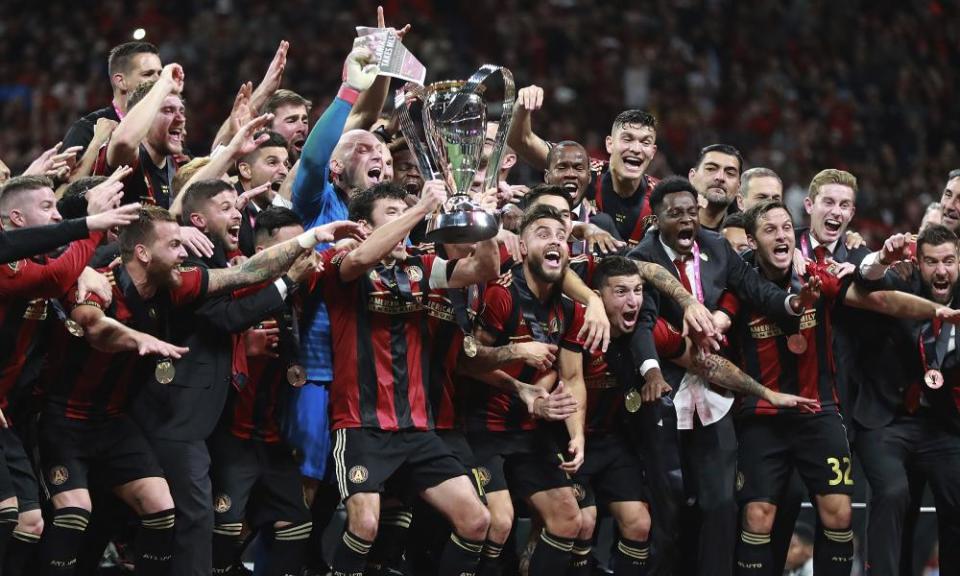Fidgety MLS changes playoffs again – this time for the better
It can be wearying to watch the league tweak the postseason again and again. But there is a certain logic behind the most recent changes

MLS president Mark Abbott has a fondness for describing the league as “nimble”. It’s a characterization that serves the league well during its more progressive moments (rapid expansion, a willingness to embrace technology, etc), though at other times it evokes some of the league’s historical flightiness and lightweight addiction to novelty over tradition. Where to place the tinkering of playoffs in this continuum?
Yes, the MLS playoffs are changing format again for next year. In an attempt to reward regular-season excellence, while balancing the desires of owners to maintain interest at the gates throughout the year, the playoff field has been expanded. Meanwhile, the route to MLS Cup for lower-ranked teams has become more of an exercise in threading the needle than the current format.
It’s an attempt at competitive integrity and condensing the competition to avoid the international break (nimble) while yet again messing with a format that might benefit from a little consistency (fidgety).
After an initial play-in round, the contest is now a straight bracket. Seven teams will qualify from each conference, with only the winners of each conference receiving an automatic bye to the second round. The remaining six seeded teams will play 2 v 7, 3 v 6, 4 v 5 in single elimination games for the right to advance to the conference semi-finals — which, along with the final, will also be single knockout game.
▪️ Single-game rounds
▪️ All between Oct/Nov FIFA breaks
▪️ Rewards regular-season success
Our new @Audi #MLSCupPlayoffs format: https://t.co/stSKmmToih pic.twitter.com/3uogrh4jCy— Major League Soccer (@MLS) December 17, 2018
In all cases, including the final, the team with the higher seeding automatically host. So the Supporters Shield winner, for example, will play their entire post-season, including a possible final, at home. A team seeded 14th could only win MLS Cup by winning four straight games on the road. The whole competition would be wrapped up by mid-November — rolling back the slow creep of the MLS post-season in recent years.
So, gone are the short turnaround play-in games that immediately cut the field by a third while nobody’s watching (the two day ticket sale lead-in to Halloween games had some predictable attendance outcomes). Gone are the two legged conference finals whose scheduling somehow always seemed to tilt the balance of power away, rather than towards, the team with the higher regular season finish. Gone too is the awkward international break hiatus that used to kill momentum right in the middle of the conference finals. And gone too are the December MLS Cups, which too often left fans watching teams like Toronto with chattering teeth.
It will be a brisk three-week race to the title, with the fixed bracket evoking other competitive institutions such as March Madness — in what may help pitches to TV and sponsors.
Compared to the current format, and beyond a snappier schedule, the improvements seem obvious. Home advantage should matter, but under the current format, in the short turnaround from Decision Day to the midweek play-in games, higher seeded clubs can struggle to fill their stadiums. If anything, the flat atmosphere in Dallas, for example, favored Portland Timbers this year, and they duly dispatched the hosts and moved on, with momentum, to host the first-leg of their conference semi-final against the Sounders, en route to an MLS Cup appearance.
In the new format, a Timbers win would likely have only earned them another trip on the road for another single game knockout match. Win that game and results elsewhere might see them host the Western Conference final, but then be on the road again for MLS Cup. Don’t like it? Finish higher in the regular season.
Of all the revisions, the expanded field may initially be the most controversial. The criticism of the regular season is that it’s way too forgiving of inconsistent teams, and doesn’t sufficiently reward the teams who played well all year. The league’s logic is that modestly growing the field will actually keep the proportion of qualifying teams roughly where it is now, as the era of rapid expansion continues to add to the number of teams in the league.
Supporters of the current system might argue that after the crapshoot of the play-in games, the two-legged system for conference semi-finals and finals is a fairer referendum on who should progress. It’s a format that notionally favors disciplined teams like Columbus and Sporting KC as they execute a plan over two legs to see off more mercurial opponents (both lost their conference semi-finals this year for what it’s worth). And again, win your conference, host your games. If you then lose at home, with time to sell tickets, you can’t have many complaints.
The new format will still mean some abrupt exits, but whereas Dallas, DC Philadelphia and LAFC were bundled out of the playoffs having barely absorbed being in them in the first place, the new format promises to build from the momentum leading to the regular season Decision Day, while still maintaining some of the meaningful advantages earned by teams over the course of many months.
So is this all for the better? It can certainly be wearying watch MLS roll out format tweaks and rule changes like so many patches for buggy software, without fixing the underlying architecture. But in this case, assuming playoffs are an unshakeable part of American soccer and sporting culture (and they are), this is about as strong a recalibration as it’s possible to get.
Just don’t get comfortable with it.
